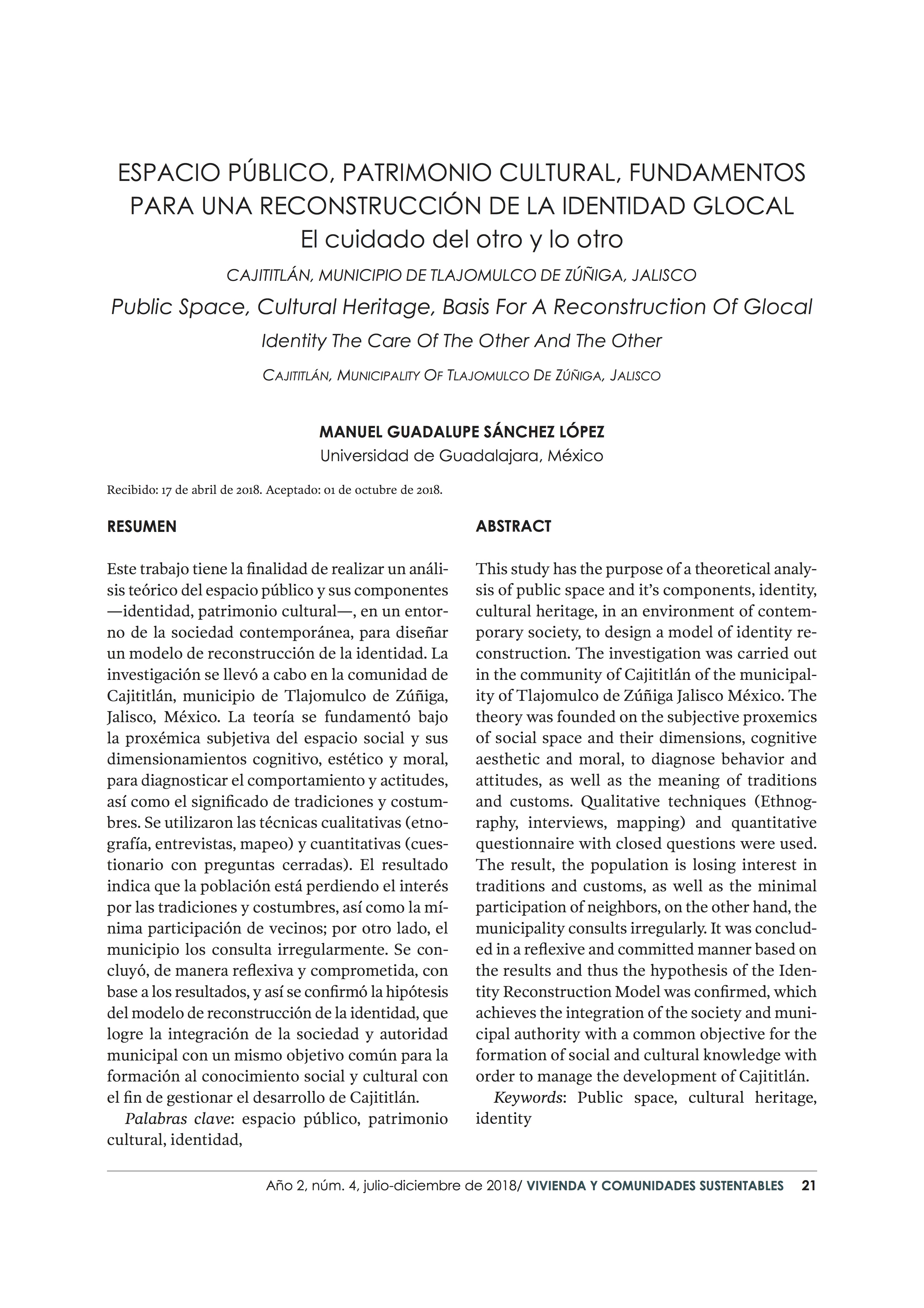Architecture Of The 20th Century In The Patrimonial Inventory Of Quito
DOI:
https://doi.org/10.32870/rvcs.v0i4.93Keywords:
architecture, identity, patrimonial inventory, modernity, symbolic productionAbstract
The modern architectural heritage of Quito has not been identified, evaluated or protected. The Metropolitan Institute of the Patrimony of Quito has preselected 125 architectural objects, but none is included in the protected nal catalog. The present investigation makes a review of the basic principles of modernity from global visions to review them directed towards a Lat- in American perspective from the point of view of Bolivar Echeverria and other Latin American authors in order to determine the need to define with more precision the parameters of evaluation of the properties to be patrimonized. At present, the Metropolitan Institute of Patrimony does not have the theoretical or critical tools to carry out this task, the product of a deep knowledge gap in the subject of local modernity. In addition, as it is exposed in the article several of the buildings currently patrimoniadas that belong to the stage already of modernity in the city do not have a theoretical endorsement that guarantees their patrimonial quality. Therefore, there is evidence of the need to study the particularities of modernism in terms of local cultural expression as a premise and basis for subsequent identification, assessment, and protection of the modern heritage of the city.Metrics
References
Andrade H., J. (8 de Mayo de 2018). El catálogo patrimonial de la ciudad de Quito. (M. González, & S. Camacho, Entrevistadores)
Augé, M. (2005). Global Local Universal Particular. Barcelona: CIDOB.
Bauman, Z. (1997). La posmodernidad y sus descontentos. Madrid: Akal.
Benavides Solís, J. (1995). La arquitectura del siglo XX en Quito. Quito: Banco Central del Ecuador. Benjamin, W. (1934). La obra de arte la época de su reproductibilidad técnica. México: Itaca.
Browne, E. (1991). "Algunas características de la nueva arquitectura latinoamericana". En C. Fernández Cox, E. Browne, C. E. Comas, R. Santa María, F. Liernur, A. Dewes, & M. Waisman, Moderidad y Posmodernidad en America Latina (pp. 23-33). Bogotá: Escala.
Choay, F. (1992). Alegoría del patrimonio. Barcelona: Gustavo Gili.
Delgado, M. (1999). El animal público. Barcelona: Anagrama.
DOCOMOMO. (2017). docomomo Ecuador. Obtenido de http://docomomo.ec/: http://docomomo.ec/ Obras/Fichas
Echeverría, B. (2009). ¿Qué es la modernidad? México: UNAM.
https://doi.org/10.2307/j.ctv1xxw14
Fernández Cox, C. (1991). "Modernidad apropiada". En C. Fernández Cox, E. Browne, C. E. Comas, R. Santa María, F. Liernur, A. Dewes y M. Waisman, Modernidad y posmodernidad en América Latina (págs. 11-22). Bogotá: Escala.
Habermas, J. (1997). "Arquitectura moderna y pos- moderna". En N. Leach, Rethinking Architecture (pp. 225-235). New York: Routledge.
Hall, E. T. (1976). Más allá de la cultura. Barcelona: Gustavo Gili.
Harvey, D. (1990). La condición de la posmodernidad. Buenos Aires: Amorrortu.
Jameson, F. (1997). "The cultural logic of late capitalism". En N. Leach, Rethinking Architecture (pp. 238-247). New York: Routledge.
Loor, J. M. (17 de septiembre de 2017). El catálogo de la arquitectura moderna en la ciudad de Quito. (S. Camacho, entrevistador)
Loor, J. M. (17 de septiembre de 2017). La arquitectura moderna en el inventario patrimonial de Quito. (S. Camacho, entrevistador)
Mann, M. (1991). Las fuentes del poder social. Tomo I. Madrid: Alianza.
Moreira, R. y Álvarez, Y. (2004). Arquitectura de Quito. 1915-1985. Quito: Trama.
Ortiz, A. (2004). Guia de arquitectura de Quito. Quito: Junta de Andalucía.Pontificia Universidad Católica del Ecuador puce. (2004). Quito 30 años de Arquitectura Moderna 1950-1980. Quito: TRAMA.
Salgado, M. (2016). La arquitectura modernista a mediados del siglo XX en Quito como articulación preponderante del proceso de desarrollo de la imagen urbana de la ciudad. Quito: Universidad Simón Bolívar.

Downloads
Published
How to Cite
Issue
Section
License
Copyright (c) 2018 Vivienda y Comunidades Sustentables

This work is licensed under a Creative Commons Attribution-NonCommercial-NoDerivatives 4.0 International License.
The authors who publish in this journal accept the following conditions:
In accordance with the copyright legislation, Sustainable Housing and Communities recognizes and respects the moral right of the authors, as well as the ownership of the patrimonial right, which will be transferred to the University of Guadalajara for its dissemination in open access. Sustainable Housing and Communities does not charge authors for submitting and processing articles for publication. Authors may make other independent and additional contractual agreements for the non-exclusive distribution of the version of the article published in Sustainable Housing and Communities (for example, include it in an institutional repository or publish it in a book) as long as they clearly indicate that the work is published for the first time in Sustainable Housing and Communities.





